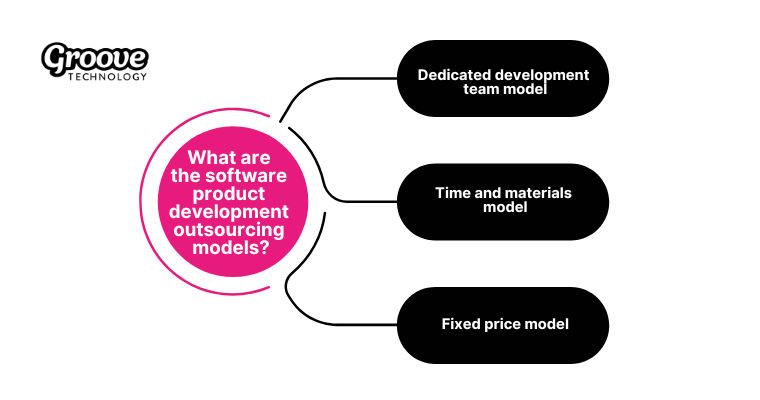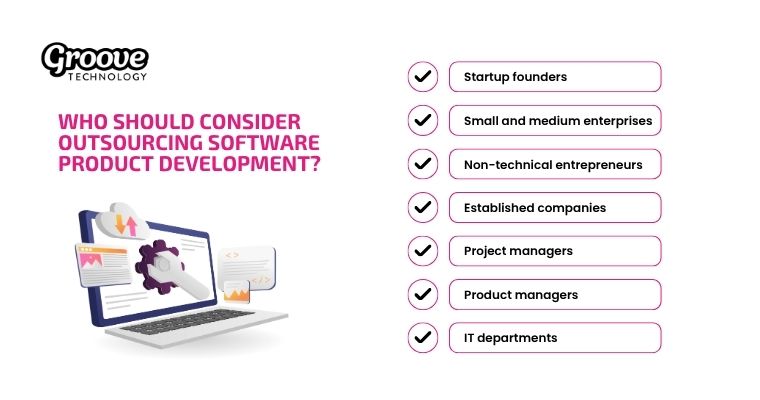What is Software Product Development Outsourcing? How To Outsource?
Software product development outsourcing involves partnering with external organizations to handle complete or partial creation, maintenance, and enhancement of software products. This strategic approach reduces labor and operational expenses while providing access to a global network of skilled developers and specialized expertise.
In fact, in 2023 alone, outsourced product development led the IT services sector with a market value of $484.86 billion. From tech giants like Amazon and Google to startups and mid-sized enterprises, companies of all sizes are leveraging this model to stay agile and competitive. Keep reading to discover how the right outsourcing partnership can transform your product development process and unlock long-term business value.

1. What is software product development outsourcing?
Software product development outsourcing is a strategic approach where businesses entrust part or all of their software creation process to an external partner.
Rather than managing every stage in-house, companies collaborate with specialized vendors who handle everything, from ideation, UI/UX design, and coding to testing, deployment, and long-term maintenance. This model allows organizations to reduce operational costs, speed up delivery timelines, and focus on their core business while tapping into world-class technical expertise that may not exist internally.
Unlike short-term contracting, outsourcing in this context is about building a long-term partnership. The external team becomes an extension of the client’s organization, actively contributing to product strategy, designing scalable architectures, and ensuring every deliverable aligns with business goals. With access to global talent through offshore, nearshore, or onshore models, companies can easily scale resources up or down based on project complexity, time zones, or budget requirements. This flexibility makes outsourcing not just a cost-saving tactic, but a growth enabler.
The practice itself is not new, but its importance has surged, especially since the pandemic normalized remote collaboration. Global tech giants like Google, WhatsApp, and Microsoft have all leveraged outsourcing to accelerate innovation and optimize costs. For example, WhatsApp outsourced its early app development to Eastern Europe to shorten time to market, while Google partnered with external teams in India to develop parts of the Android ecosystem. Similarly, Microsoft relies heavily on offshore developers across Asia to build and maintain many of its flagship products.
These real-world examples highlight how outsourcing has evolved into a core business strategy rather than a temporary solution. Market data also supports this shift: the IT outsourcing industry was valued at $525.2 million in 2022 and is projected to reach $725.6 million by 2030. According to STX Next’s Global CTO Survey (2021), 89% of CTOs plan to continue outsourcing software development. Meanwhile, GlobeNewswire forecasts the global outsourced product development market will hit $425.19 billion by 2026.
With success stories from companies like Skype, Opera, and WhatsApp, it’s clear that outsourcing has become a proven path to achieving faster innovation, operational efficiency, and competitive advantage in the software industry.

>>> Discover more: What is a software outsourcing company? Full Guide 2025
2. When do you need to consider software product development outsourcing?
Seven distinct scenarios indicate when organizations should consider outsourced software product development partnerships for optimal project outcomes and strategic advantage.
- Technical capability gaps: Organizations lacking specialized expertise often require experienced professionals to handle complex development phases, make informed decisions on advanced architecture, and implement sophisticated strategies for successful project completion.
- Human resource constraints: Recruitment difficulties and talent retention challenges create operational gaps that external specialists bridge, providing immediate access to skilled developers without the need for lengthy hiring processes or training overhead.
- Accelerated timeline requirements: Project deadlines that demand rapid delivery benefit from agile external teams that distribute workloads efficiently and accelerate development cycles through proven methodologies and streamlined workflows.
- Non-strategic activity delegation: Software development tasks outside core business competencies should be assigned to specialized experts, allowing internal teams to concentrate on strategic initiatives and customer-focused activities.
- Regulatory compliance challenges: Market barriers in regulated industries necessitate compliance expertise and streamlined processes, which outsourcing partners deliver through industry-specific knowledge and regulatory navigation experience.
- Innovation and differentiation needs: Unique product concepts that require fresh perspectives and top-tier talent benefit from external teams that bring diverse experience and specialized skills to create distinctive market solutions.
- Resource flexibility requirements: Dynamic project needs, spanning from initial prototyping to final product refinement, demand scalable team structures that external partners can provide without fixed employment costs or infrastructure investments.

3. Advantages of software product development outsourcing
There are five clear advantages that make outsourcing software product development a strong growth driver for businesses seeking to expand more quickly and manage operations more efficiently.
- Global expertise reach: Outsourcing connects companies with skilled professionals across different countries, solving the problem of limited local talent that affects nearly half of U.S. firms. Global collaboration also fosters diverse thinking and brings specialized technical knowledge, thereby strengthening product innovation and overall performance.
- Agile resource scaling: Flexible resource allocation enables businesses to scale their teams up or down based on project size or urgency, eliminating the need for lengthy recruitment processes. Deloitte’s research shows that over 50% of executives face hiring delays, which makes on-demand scalability a key operational advantage.
- Accelerated market entry: Faster product delivery becomes achievable as external teams work across time zones and maintain continuous progress cycles. Internal teams can stay focused on strategic goals while outsourced developers handle implementation and testing, enabling businesses to release products earlier than their competitors.
- Optimized cost–value balance: Outsourcing enables organizations to manage their budgets more effectively without compromising product quality. Around 57% of business leaders cite cost savings as the primary reason for outsourcing, as it enables them to redirect financial resources toward marketing, customer acquisition, or future product updates.
- High-standard deliverables: Experienced outsourcing vendors bring strong technical knowledge, proven development frameworks, and established quality control methods. This expertise directly enhances customer satisfaction and profit margins by delivering reliable software that performs effectively in real-world conditions.
- Reduced onboarding overhead: Unlike hiring in-house staff, outsourcing eliminates the lengthy 3–6 month onboarding cycle. External teams are already experienced, familiar with collaboration frameworks, and can start contributing within days.
- Internal focus on core competencies: Outsourcing reduces the need for businesses to handle HR-intensive tasks, such as training programs, evaluations, and retention activities, freeing internal teams to focus on strategic goals and product innovation.

4. Disadvantages of outsourcing software product development
There are specific situations where outsourcing software product development becomes not just beneficial, but essential. However, these decisions should always be weighed alongside the challenges of software development outsourcing. Below are some common scenarios that signal it’s time to consider outsourcing.
- Communication Barriers: Time zone differences, linguistic variations, and cultural distinctions create misunderstandings that disrupt project timelines, requiring structured communication protocols and regular synchronization meetings to maintain alignment.
- Data Security Vulnerabilities: The sharing of sensitive information increases exposure to potential breaches and intellectual property theft, necessitating robust cybersecurity frameworks and comprehensive confidentiality agreements to protect valuable assets.
- Cost Transparency Issues: Ambiguous initial pricing structures often lead to unexpected fees and budget overruns, complicating financial planning and requiring detailed contract specifications with clear cost breakdowns.
- Resource Dedication Concerns: External developers managing multiple concurrent projects may compromise attention and deliverable quality, potentially affecting project outcomes and organizational reputation through divided focus and competing priorities.
- Operational Control Limitations: Reduced direct oversight compared to internal teams can lead to project delays and quality inconsistencies, necessitating enhanced monitoring systems and clear performance metrics for accountability.

5. What are the software product development outsourcing models?
There are three main types of outsourcing that companies can adopt based on their project goals, budget, and management style. Each model defines how the collaboration works, what level of control the client has, and how costs and responsibilities are distributed throughout the project lifecycle.
- Dedicated software development team model: Dedicated model involves a group of professionals who work exclusively on a single client’s project. The client manages the workflow, sets priorities, and determines the team composition, while the outsourcing vendor handles recruitment and administration. This model offers flexibility for complex projects, cost efficiency compared to full-time hiring, and continuity, as the same developers remain engaged throughout the product’s development.
- Time and materials model: This model charges clients based on the actual hours worked and materials used. It is suitable for projects where requirements evolve over time or where the scope is not fully defined at the start. The benefits lie in adaptability, as clients can adjust resources during the process, cost transparency, as they pay only for completed work, and access to specialized talent that strengthens productivity and product quality.
- Fixed price model: This model sets a total project price before development begins, based on clearly defined deliverables and deadlines. It works best for projects with stable goals and predictable outcomes. The advantages include predictable costs that simplify budgeting, clear control over timelines and deliverables, and reduced financial risk since price and scope are agreed upon upfront.

6. Who should consider outsourcing software product development?
Outsourcing software product development, especially outsourcing software development for startups, suits seven main groups of businesses that need flexibility, speed, or specialized expertise to achieve their goals:
- Startup founders: Early-stage founders rely on outsourcing to build products faster with limited budgets. By working with scalable, fully managed teams, they save time on hiring and coordination while maintaining focus on core business activities that drive growth.
- Small and medium enterprises (SMEs): SMEs aiming for expansion use outsourcing to fill capability gaps without forming a full in-house team. They can choose between staff augmentation for extra support or end-to-end outsourcing for complete product development, depending on their workload and technical maturity.
- Non-technical entrepreneurs: Entrepreneurs without coding or management experience depend on outsourcing partners to develop software ideas into working products. Collaborating with cross-functional teams enables them to achieve long-term scalability while aligning technical execution with business objectives.
- Established companies: Large enterprises facing capacity limits or seeking innovation use outsourcing to access specialized skills. They often combine staffing models with managed services to achieve greater control and creative input, striking a balance between productivity and fresh external perspectives.
- Project managers: Project managers handling complex initiatives benefit from outsourcing when timelines are tight or specific skills are missing internally. By choosing the right outsourcing model, they gain flexibility in managing schedules, team composition, and deliverables.
- Product managers: Product managers driving new launches turn to outsourcing to reduce time to market and maintain efficiency. Collaborating with technical product managers helps synchronize external workflows with the company’s strategic vision and customer expectations.
- IT departments: Internal IT teams facing overload or specialized technical needs outsource to freelance or agency teams. This approach enables them to address urgent challenges, enhance operational efficiency, and manage projects effectively without incurring long-term recruitment costs.

7. How much does it cost to outsource software product development?
The outsourcing software development cost varies greatly by region, experience level, and project type. On average, outsourcing ranges from $20 to $150 per hour, or approximately $50,000 to $375,000 for a simple application that requires around 2,500 development hours.
| Region | Average Hourly Rate (USD) | Example Cost for Simple App (≈2,500 hours) |
| USA (North America) | $100 – $150/hour | ≈ $250,000 – $375,000 |
| Latin America | $45 – $65/hour | ≈ $112,500 – $162,500 |
| Central & Eastern Europe | $30 – $55/hour | ≈ $75,000 – $137,500 |
| Asia (e.g., India, Vietnam) | $20 – $45/hour | ≈ $50,000 – $112,500 |
Each region offers different cost levels and working advantages, providing companies with flexibility to choose based on their budget, time zone, and communication preferences.
- USA (North America): The United States remains the most expensive destination, with developer rates averaging $100–150 per hour. A simple app that takes around 2,500 hours may cost between $250,000 and $375,000, prompting many American companies, including major tech firms, to outsource overseas for better value.
- Latin America: Countries such as Mexico, Argentina, and Brazil offer a cost-effective nearshore option, with hourly rates ranging from $45 to $65. Companies benefit from overlapping time zones and convenient travel for collaboration, though cultural and language adjustments may be needed in some cases.
- Central & Eastern Europe: This region has become a major outsourcing hub due to its strong STEM education and skilled workforce. Developers usually charge $30–55 per hour, creating a good balance between cost and quality. Popular outsourcing countries include Poland, Ukraine, and Romania, where reliability and communication standards are high.
- Asia (e.g., India, Vietnam): Asia offers the most affordable outsourcing costs, typically ranging from $20 to $45 per hour. The large talent pool allows companies to access developers quickly and scale easily, though outcomes can vary depending on the vendor’s quality standards and management practices.
8. Comparing software outsourcing vs software product development outsourcing
Although the terms are often used interchangeably, software outsourcing and software product outsourcing are fundamentally different in scope, goals, and involvement.
- Software outsourcing typically focuses on executing specific technical tasks (mainly coding and development) based on a predefined plan or requirements. In software outsourcing, the outsourced team is usually given a task list and is responsible for delivering code that meets the specifications.
- Software product development outsourcing, on the other hand, covers the entire product lifecycle. This includes ideation, market research, strategy development, implementation, ongoing maintenance, and updates. In product outsourcing, the team is deeply involved from the very beginning. They collaborate on shaping the product vision, defining market fit, and continuously adjusting the roadmap based on user feedback and business goals.
| Aspect | Software Outsourcing | Software Product Development Outsourcing |
| Scope | Limited to designated phases, including coding, testing, and maintenance | Encompasses full product lifecycle: strategy, design, development, quality assurance, deployment, support |
| Client Responsibility | Managing requirements, project direction, and system integration | Minimal oversight with external teams managing processes, quality, and product direction |
| Vendor Responsibility | Executing assigned tasks according to client specifications | Delivering market-ready products with innovation and roadmap accountability |
| Project Type | Well-defined, short-term, or modular initiatives | Long-term, strategic, innovation-driven product development |
| Management Approach | Requires hands-on client oversight and coordination | Vendor-managed project coordination and quality control |
| Expertise Access | Specific technical skills and resource augmentation | Multidisciplinary teams spanning strategy, UX/UI, development, QA, and DevOps |
| Best Applications | Companies with clear specifications needing skill gaps filled or rapid scaling | Businesses lacking technical expertise seeking new product development or innovation |
9. Top 3 companies for software product development outsourcing
Choosing the right software product development partner is crucial for long-term business success. Below are three top outsourced software development companies, recognized for their technical expertise, global experience, and ability to support clients from concept to full product delivery.
- Groove Technology
Founded in 2016, Groove Technology is a Vietnam-based software development company that provides comprehensive product development solutions to global clients. Unlike traditional outsourcing vendors, Groove joins projects from the concept stage and continues through maintenance and support, creating long-term value and reliability for its clients.
The company holds certifications such as ISO 9001 for Quality Management and ISO/IEC 27001 for Information Security, which reflect their commitment to consistency, continuous improvement and data protection. Groove Technology’s team also includes certified Scrum Masters, Product Owners, and PMP project managers, ensuring that every project follows structured methodologies while remaining flexible to business needs.
Key strengths:
- Flexible and transparent development process supported by Agile and Scrum certifications
- Experienced engineers with global certifications in Java, .NET, React, Angular, and AWS
- ISO 9001 and ISO/IEC 27001 certifications guarantee quality and information security
- Full-cycle product development from strategy to maintenance
- Scalable delivery structure led by PMP-certified project managers
Groove Technology’s recognitions, including “Clutch Top Software Company in Vietnam” and “Great Place to Work,” reinforce its strong reputation. The combination of technical certifications, structured workflows, and positive workplace culture makes it a trusted partner for businesses seeking consistent quality and long-term collaboration.

- Saigon Technology
Established in 2012, Saigon Technology is a leading Vietnam’s outsourced software product development company, specializing in custom software development and SaaS product solutions for international markets. With a team of over 400 engineers, they’ve served hundreds of clients in the US, Australia, and Asia. Known for their cost-efficiency and transparent workflow, Saigon Technology is a go-to partner for startups and SMEs.
Key strengths:
- ISO 9001 & ISO/IEC 27001 certified
- 400+ skilled software engineers
- Competitive pricing ideal for startups & SMEs
- Proven track record with global clients
- BairesDev
Founded in 2009 in Latin America, BairesDev is a leading software product development company offering high-end outsourcing services. They’ve worked with global giants like Google, Pinterest, and Rolls-Royce. BairesDev’s elite engineering team operates under a “Time Zone Aligned” model, making them an efficient and responsive choice for North American clients seeking performance and product excellence.
Key strengths:
- 3,000+ top-tier engineers worldwide
- Trusted by Fortune 500 companies
- Time zone–aligned delivery model
- Strong focus on performance, quality, and security
10. How to outsourced software product development right?
Software product development outsourcing can be a strategic advantage if done correctly. To ensure success, businesses should follow a structured approach that minimizes risks, aligns expectations, and maximizes value. Here's a step-by-step guide on the outsourcing software development process and how to effectively outsource your software product development:
- Clearly define goals and product requirements: Before you begin outsourcing, take time to define what you’re building, who it’s for, and what features are essential. A clear project scope, timeline, and budget will help you find the right partner and avoid misunderstandings.
- Choose the right model and a trusted vendor: Depending on your project’s scope, you can opt for a fixed-price model, a dedicated development team, or staff augmentation. Evaluate vendors based on hands-on experience, domain knowledge, communication skills, and verified client testimonials.
- Establish a transparent and flexible collaboration process: Use project management tools (like Jira or Trello) and communication platforms (such as Slack or Zoom) to track progress and coordinate seamlessly. Agree on workflows for feedback, issue resolution, and scope changes if needed.
- Create a clear contract and start with a pilot project: A solid contract should outline deliverables, timeline, intellectual property rights, and confidentiality terms. To reduce risk, begin with a smaller pilot project to validate the partner’s capabilities and working style.
- Monitor progress and ensure post-delivery support: Throughout development, conduct regular quality checks, provide ongoing feedback, and ensure complete handover of documentation, source code, and technical assets. Also, negotiate post-launch support and maintenance in advance.

Conclusion
This comprehensive guide examines the fundamentals of outsourced software product development, covering strategic implementation timing, competitive advantages, potential drawbacks, and practical execution frameworks. Readers gained insight into distinguishing between traditional outsourcing and comprehensive product development partnerships, while also understanding vendor evaluation methodologies and best practices for collaboration.
Groove Technology provides specialized software product development outsourcing services designed to transform business concepts into market-ready solutions through transparent processes and expert collaboration. Our dedicated teams handle complete product lifecycles while allowing clients to focus on core business strategies and market expansion initiatives.
Related Articles:
- Why Outsource Software Development: 7 Key Benefits
- Best Practices for Hiring Outsourcing Software Developer Teams
- How to Outsource Software Development Projects Successfully





